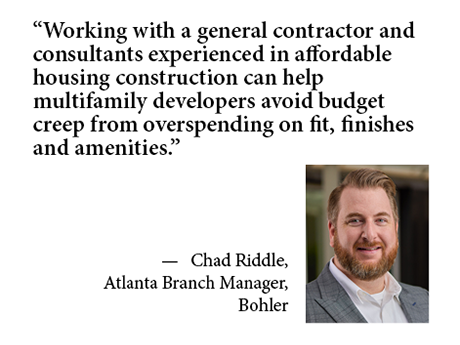With elevated prices on everything from land to debt financing, insurance, building materials and labor, developers face an uphill climb attempting to pencil out multifamily projects at a profit.
That’s why in 2024, developers are opting for practical and convenient amenities over luxury and choosing builder-friendly suburban locations over complex urban sites. And with diminishing room to raise rents on market-rate apartments, many investors and developers are shifting their attention to affordable and workforce housing, where incentives offset some expenses and, ideally, help position projects to deliver positive returns.
“Market-rate developers in our region are starting to change their model to embrace more of an affordable product,” confirms Chad Riddle, Atlanta branch manager at Bohler. “Unfortunately, that puts them behind the eight ball because they may not know the tricks of the trade and they are competing with affordable housing developers that already know the business and are thriving.”
There is no single strategy to pencil out a profitable multifamily project, but developers are achieving success by sticking to proven, cost-effective design elements and amenities, avoiding costly missteps and cutting down unnecessary spending throughout the development process. Drawing on affordable housing specialists and other in-house experts, Bohler helps clients avoid pitfalls and adhere to the best practices of the industry’s most experienced developers.
What follows are key cost-saving considerations to deliver cash-flowing multifamily product without sacrificing profitability in today’s high-cost marketplace.
Make a Good Start
Site selection is one of the greatest contributors to project cost because it influences not only the price of land but also the effort and expense required for municipal approvals, removal or renovation of existing structures, site preparation and any improvements the municipality may require in the surrounding community. It’s no wonder that the bulk of new projects are rising in suburban communities with vacant land ready for new construction.
“A lot of developers won’t touch urban infill with a 10-foot pole right now because it is hard to pencil,” Riddle says. “Redevelopment is almost as expensive as building new. If you have to tear down a building, that’s a whole line item of cost that could be eliminated by picking a vacant lot on a metro’s perimeter and just building from the ground up.”
Suburban communities are often more accommodating to new housing, especially new affordable housing. That can lead to additional incentives or expedited approvals that reduce costs. By the same token, Riddle encourages developers to inquire early on about any long-term expectations the municipality may harbor for the area and to avoid proposing a project that conflicts with those plans.
Be Mindful of the Market
Evolving occupier preferences and developers’ desire to reduce construction and operating costs are changing the type of amenities offered at new multifamily properties, Riddle says. Successful projects provide amenities that deliver a return on investment and avoid duplication by taking advantage of area resources, such as access to parks, transportation and services that add to their projects’ appeal.
“Consumers have moved past striving for high-end appliances and square footage in their unit,” Riddle says. “People have started equating excess square footage with higher heating and cooling costs. They’d rather be in a multifamily development that’s accessible to food delivery services, with an easy-to-navigate protocol set up to get their deliveries and packages quickly.”
“Working with a general contractor and consultants experienced in affordable housing construction can help multifamily developers avoid budget creep from overspending on fit, finishes and amenities,” Riddle says. Several Bohler clients that have changed gears from market-rate to affordable housing have also changed contractors. “They don’t want to get down the line with a market-rate general contractor who is building-in market-rate practices and costs in what they intend to be an affordable product,” he says.
Smart Amenities
Renters are increasingly interested in technology and convenience, and developers are leveraging that trend to enhance the resident experience at a relatively low cost.
“Being able to control things from your phone is a huge amenity right now,” Riddle says, referring to smart appliances and platforms that enable residents to adjust heating, cooling and other systems in their units remotely.
Some technologies, including smart locks, may even lower property operating costs. As an amenity, digital locks give residents unit access with a code, so they don’t have to keep track of keys. But for the property operator, programable locks can eliminate hours of labor once spent replacing locks when units rolled over to new occupants. Capturing similar savings opportunities throughout the development process can make the difference between a profitable project and one that ends up underwater, Riddle says.
“If you can sit at a computer and reprogram 30 locks in 10 or 20 minutes, that helps reduce cost,” he says. “Those crumbs of savings add up, and crumbs make a cake.”
Time-saving technology, combined with savvy site selection and cutting down on budget creep wherever possible, is an approach that’s delivering multifamily developments with everything communities want and leaving out anything that isn’t needed.
— By Matt Hudgins. Bohler is a content partner of REBusinessOnline. For more articles from and news about Bohler, click here.


